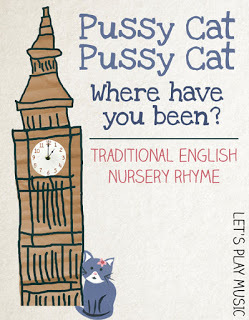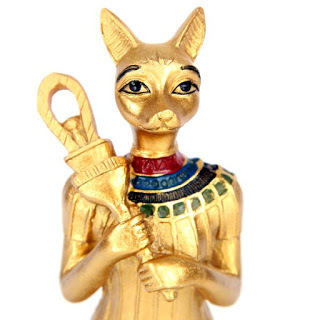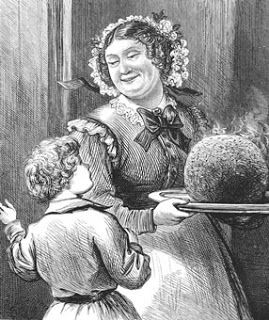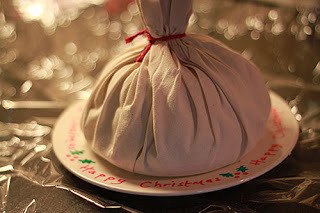Hey Diddle Diddle: Cats and Nursery Rhymes
I never was a huge fan of nursery rhymes. Although they are meant to entertain small children, I always found them slightly sinister. This is perhaps backed up by the eldest son, who when little used to think the words to “Baa Baa Black Sheep” went:
Baa, baa, black sheepHave you any wool?Yes, sir, yes, sir, Three bags full;One for the monster ….
Obviously this should have been master, but my son misheard.Perhaps I would have liked these rhymes more if they featured cats. So let's see what is on offer.

The Cat and the FiddleHey diddle diddle, the cat and the fiddle, The cow jumped over the moon,The little dog laughed to see such funAnd the dish ran away with the spoon

What is the significance of the “cat and the fiddle”?There are several different explanations.
One is that the cat is code for Queen Elizabeth I, and is a comment on her evasive behavior with foreign diplomats. She is famous for skillfully manipulating those emissaries sent by foreign princes to negotiate a marriage contracct with Elizabeth. Some believe this nursery rhyme is a comment on her ability to fiddle and pull the diplomates' strings and play with them as a cat does mice – especially as she never married and was famous for being the virgin Queen. However, nice as this story is, sources believe Hey Diddle Diddle was written around 200 years after her reign – which hardly makes it topical and top of the rhyme-makers mind. A representation of Bastet
A representation of Bastet
holding a sistrum
Perhaps more convincing is the explanation likening the words to a description of a type of ancient Egyptian instrument called a sistrum. Many ancient depictions of the cat-goddess Bastet show her holding a sistrum which is fiddle-shaped. Intriguingly, the cow and the moon could be represented by another Egyptian goddess, Hathor, who bore horns on her head between which is suspended a large disc.
Alternatively, the “cat and fiddle” could be a corruption of the Latin expression “catus fideles” meaning faithful cat, but to the untrained ear sounding like ‘cat and fiddle’.
The Cat and the Pudding StringSing, sing, what shall I sing?The cat’s run away with the pudding string. Do, do, what shall I do?The cat’s run away with the pudding too.
This rhyme is altogether more straightforward. If you’ve ever made traditional Christmas puddings, you’ll have some idea what this is about. The pudding ingredients are mixed and then placed within a large muslin cloth which is gathered around the mix and tied off. The pudding is then steamed or boiled. Obviously, a playful cat took a fancy to the securing string and played with it. Perhaps the cook saw what kitty was about and chastised her, at which point the cat takes off with the string in her mouth and pulls the pudding after her.Simple! (Must have been a small pudding though.)
Going to Saint IvesAs I was going to Saint Ives, I met a man with seven wives;Every wife had seven sacks;Every sack had seven cats;Every cat had seven kitsKits, cats, sacks, and wives. How many were there going to Saint Ives? Beautiful St Ives on the Cornish coast of England
Beautiful St Ives on the Cornish coast of England
This one is my favorite because on the face of things it’s a simple test of multiplication. [St Ives is a town in Cornwall.]However, is it instead a trick question? Can you be confident the man with seven wives was indeed going towards St Ives, or could he and his entourage have been walking away (and therefore making the math considerably easier!!) What do you think?

Baa, baa, black sheepHave you any wool?Yes, sir, yes, sir, Three bags full;One for the monster ….
Obviously this should have been master, but my son misheard.Perhaps I would have liked these rhymes more if they featured cats. So let's see what is on offer.

The Cat and the FiddleHey diddle diddle, the cat and the fiddle, The cow jumped over the moon,The little dog laughed to see such funAnd the dish ran away with the spoon

What is the significance of the “cat and the fiddle”?There are several different explanations.
One is that the cat is code for Queen Elizabeth I, and is a comment on her evasive behavior with foreign diplomats. She is famous for skillfully manipulating those emissaries sent by foreign princes to negotiate a marriage contracct with Elizabeth. Some believe this nursery rhyme is a comment on her ability to fiddle and pull the diplomates' strings and play with them as a cat does mice – especially as she never married and was famous for being the virgin Queen. However, nice as this story is, sources believe Hey Diddle Diddle was written around 200 years after her reign – which hardly makes it topical and top of the rhyme-makers mind.
 A representation of Bastet
A representation of Bastetholding a sistrum
Perhaps more convincing is the explanation likening the words to a description of a type of ancient Egyptian instrument called a sistrum. Many ancient depictions of the cat-goddess Bastet show her holding a sistrum which is fiddle-shaped. Intriguingly, the cow and the moon could be represented by another Egyptian goddess, Hathor, who bore horns on her head between which is suspended a large disc.
Alternatively, the “cat and fiddle” could be a corruption of the Latin expression “catus fideles” meaning faithful cat, but to the untrained ear sounding like ‘cat and fiddle’.
The Cat and the Pudding StringSing, sing, what shall I sing?The cat’s run away with the pudding string. Do, do, what shall I do?The cat’s run away with the pudding too.

This rhyme is altogether more straightforward. If you’ve ever made traditional Christmas puddings, you’ll have some idea what this is about. The pudding ingredients are mixed and then placed within a large muslin cloth which is gathered around the mix and tied off. The pudding is then steamed or boiled. Obviously, a playful cat took a fancy to the securing string and played with it. Perhaps the cook saw what kitty was about and chastised her, at which point the cat takes off with the string in her mouth and pulls the pudding after her.Simple! (Must have been a small pudding though.)

Going to Saint IvesAs I was going to Saint Ives, I met a man with seven wives;Every wife had seven sacks;Every sack had seven cats;Every cat had seven kitsKits, cats, sacks, and wives. How many were there going to Saint Ives?
 Beautiful St Ives on the Cornish coast of England
Beautiful St Ives on the Cornish coast of England
This one is my favorite because on the face of things it’s a simple test of multiplication. [St Ives is a town in Cornwall.]However, is it instead a trick question? Can you be confident the man with seven wives was indeed going towards St Ives, or could he and his entourage have been walking away (and therefore making the math considerably easier!!) What do you think?

Published on October 04, 2015 09:32
No comments have been added yet.
'Familiar Felines.'
Following on from last weeks Halloween posting, today's blog post looks at the unwanted image of cats as the witches familiar - from the Norse Goddess Freya to lonely women in the middle ages.
The full Following on from last weeks Halloween posting, today's blog post looks at the unwanted image of cats as the witches familiar - from the Norse Goddess Freya to lonely women in the middle ages.
The full post can found at:
http://graceelliot-author.blogspot.com
...more
The full Following on from last weeks Halloween posting, today's blog post looks at the unwanted image of cats as the witches familiar - from the Norse Goddess Freya to lonely women in the middle ages.
The full post can found at:
http://graceelliot-author.blogspot.com
...more
- Grace Elliot's profile
- 156 followers



